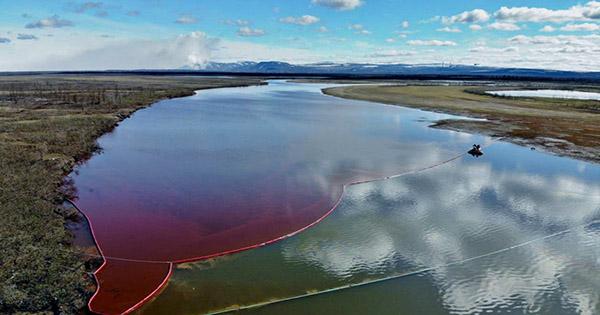Permafrost has been blamed for the recent oil spill in Siberia’s wide-spread contamination of article circles. A diesel tank from an industrial plant in the Siberian city of Norilsk began leaking about 20,000 tons of diesels into the surrounding environment, casting a shadow over the nearby Ambarnaya River, On May 29.
Russia’s state-run news agency TASS reported that Nornickel, the world’s largest nickel producer who owns the plant, argued that the digital tank began to leak diesel due to structural damage caused by melting permafrost. They claim that the concrete foundation of the diesel tank collapsed as a result of molten permafrost. Once the leak started, it was claimed; a car crashed and caught fire near the fuel spill.
Sergey Dyachenko, first vice president and operations director of Norilsk Nickel said, “The nature of the cracks in the concrete and the collapse of the supporting columns led us to believe that something had happened to the ground – probably the melting of the soil.”
Permafrost is a land that has been frozen for two or more years, although some permafrost has been frozen for thousands of years. Due to the effects of climate change, most of the Northern Hemisphere once began to melt stable permafrost, creating countless problems for further release of carbon from damaged infrastructure. According to the United Nations Intergovernmental Panel on Climate Change (IPCC), global warming will be limited to below 2 degrees Celsius, but about 25 percent of the planet’s permafrost will fall near 2100.
Anyway, some environmental groups are not convinced by Nornickel’s claim that the permafrost is to blame for the incident. While recognizing climate change and melting permafrost is a problem in the region, Greenpeace Russia has argued that the problem is being used to avoid liability for accidents.
The environmental group said the 2009 report explicitly warned how permafrost would affect oil and gas infrastructure in the Norilsk region and that the agency should have been aware of the problem. Meanwhile, the extent of the damage is beginning to become clear. The latest assessment shows that the fuel is spread over 180,000 square meters (about 1,900,000 square feet), flowing into the river and entering the ground up to 5 centimeters (2 inches). In some reservoirs in Norilsk, the water is 60 times higher than the maximum permitted concentration of hazardous substances.
Clean-up operations have been underway since the beginning of last week, although it is suspected that the legacy of environmental catastrophe will continue in the region for decades to come. Vladimir Chuprov, project director of Greenpeace Russia, said in a statement, “With the installed boom, only a small fraction of the pollution can be collected, so it can be argued that almost all diesel fuel will be in the environment.” He added, “The damage could be in the billions of rubles [$88 million]. And this is without taking into account the growing factors.”















